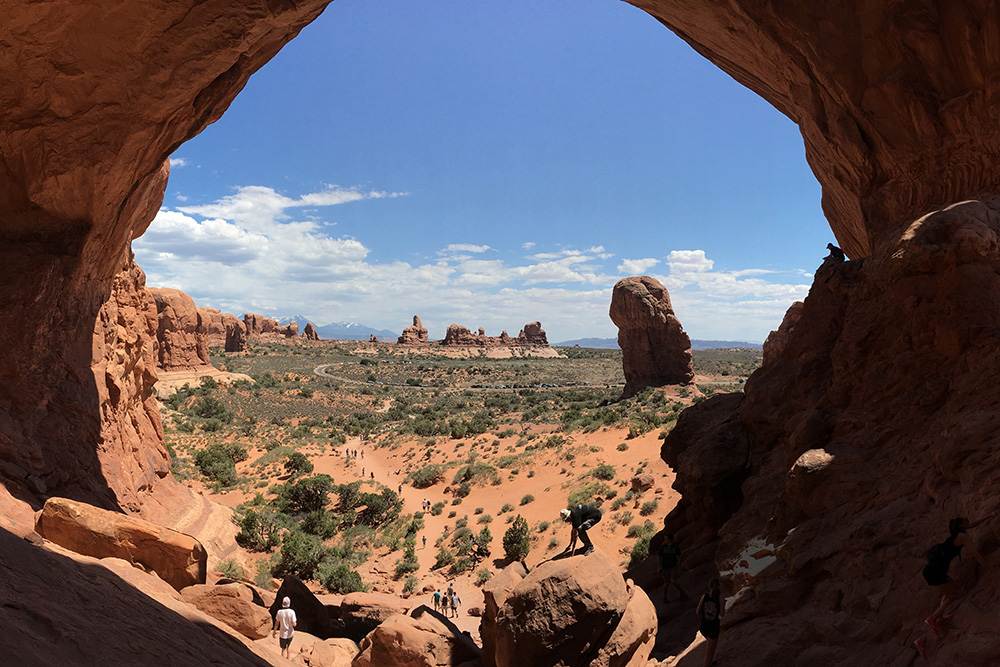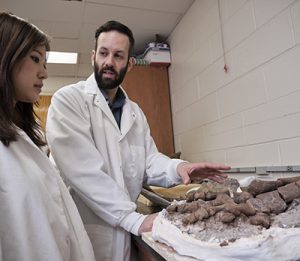A discovery in Utah by Michael D'Emic, PhD, assistant professor of biology shows that flowering trees grew in North America 15 million years earlier than previously thought.

A discovery in Utah shows that flowering trees grew in North America 15 million years earlier than previously thought.
Approximately 90 million years ago, during the Turonian period, a vast expanse of sea stretched across North America from the Gulf of Mexico to the Arctic Ocean. Along the shore in what is now Utah, pterosaurs flew in the sky, sharks swam in the water and beaked dinosaurs foraged on the land. And, thanks to a 2018 discovery by Michael D’Emic, PhD, assistant professor of biology, we now know something surprising about the forest canopies growing inland: They included flowering trees.
This groundbreaking discovery was the result of old-fashioned detective work. Visiting Utah in pursuit of dinosaur bones, Dr. D’Emic found himself face-to-face with an enormous fossilized log at least six feet in diameter. The tree seemed incongruous with its surroundings, which raised a crucial question: How did it get there? Studying the land around him, Dr. D’Emic looked for clues to recreate the events that brought the log to its final resting place. “Geologists can read rocks like a book because the type of deposition leaves a signature in the rock itself,” he explained.
What Dr. D’Emic observed was evidence of a devastating storm. Such a large log could only travel all the way to the sea by way of fast-flowing water; likewise, the sand he found embedded in the nearby stones was extremely coarse, which could only have been the result of tremendous water energy. Given the tree’s place in the rock formations, it likely arrived in its resting place around 92 million years ago.

Michael D’Emic, PhD, has made important discoveries of dinosaur remains that have led to insights on dinosaurs’ evolution and habitat. His work has been featured on National Public Radio, in Time magazine, NBC News and media outlets around the world.
But what kind of tree was the specimen? To find out, Dr. D’Emic sent a sample to Nathan Jud, PhD, assistant professor of biology at William Jewell College. After cutting three samples with a diamond rock saw, Dr. Jud mounted them to glass slides and sanded them so fine light could shine through. Under the microscope, he found a tree that was not just an angiosperm, or flowering plant, but one of a size—170 feet—not thought to exist until 15 million years later. The two presented their findings in “A new fossil assemblage shows that large angiosperm trees grew in North America by the Turonian (Late Cretaceous),” published in the September 26, 2018, issue of Science Advances.
“This discovery rewrites what we thought about the origin and evolution of large flowering trees,” Dr. D’Emic said. It also deepens our knowledge of a period with a very patchy fossil record. “Our tree fossil was discovered in a time and place with a very high sea level,” Dr. D’Emic said, “so it was an extremely fortunate and rare event that preserved it within a delta along the margins of ancient coastal Utah.”
While further research and exploration of the fossil record will be required to create a full picture of the ecosystem in which the angiosperm lived, Dr. D’Emic’s work indicates that—contrary to prior belief—dinosaurs and large angiosperms coevolved.
Changing our conception of the past has broad implications for the present and future, including our efforts to manage the effects of a changing climate. “Flowering plants are important for humans because nearly every plant we eat is an angiosperm,” Dr. D’Emic noted. “We can better learn how to predict and manage change in the future by understanding how ecosystems responded to previous environmental change.”
The location of Dr. D’Emic’s find is confidential to protect the site from poachers, but he is hopeful this discovery will spur additional explorations that produce specimens for public consumption. “We are in a golden age of paleontology,” he said. “There still remains a lot to explore.”
For further information, please contact:
Todd Wilson
Strategic Communications Director
p – 516.237.8634
e – twilson@adelphi.edu